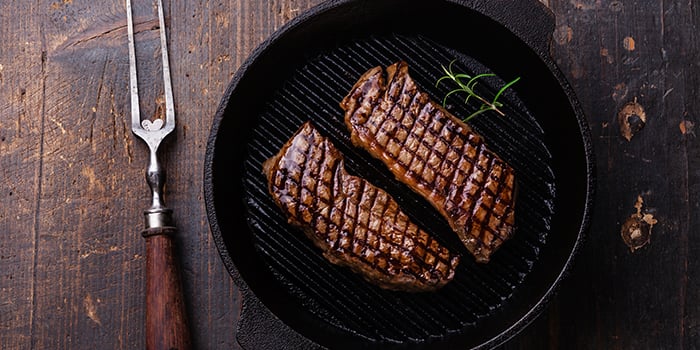How to Cook the Perfect Steak

We get it — not everyone is a fan of red meat, for a variety of reasons. But once in a while, digging into a juicy steak really hits the spot.
To help beef up your steak-cooking skills, we turned to Brian Christman, Executive Chef at Del Frisco’s Double Eagle Steak House in Manhattan.
Here are his 7 experts tips for cooking the perfect steak.
1. Choose the Right Cut
New York Strip, T-bone, and the coveted filet mignon are all fattier cuts of steak.
(A six-ounce filet has 350 calories, 15 grams of fat, and 48 grams of protein.)
However, if you had steady hands, you can parlay those skills to turn a fatty filet into a lean cuisine by removing the layer of fat from the steak’s edges.
If you lack surgical deftness with a steak knife, consider leaner cuts: top round, top sirloin, eye of round steak, and bottom round steak, and select the pieces with the least amount of visible fat.
2. Bring the Meat to Room Temp
Moving steak from the fridge directly into a piping-hot pan can cause an uneven cook or a cold center.
Let the meat sit out for about an hour before you cook it.
3. Season With Care
Wearing a vanity apron or goofy toque blanche (aka: chef’s hat), and over-seasoning steak — are three mistakes amateurs make.
Go easy on the add-ons to allow the meat’s natural flavors to take center stage.
“I recommend seasoning generously with salt and pepper only to let the meat shine,” explains Christman.
As for rubs or marinades, rubs might be more effective for adding flavor to thicker slabs of meat.
For a marinade to penetrate deep into a beefy cut of steak, you’d have to make a bunch of holes in the flesh — bad move.
Why? Because poking holes in the flesh causes the steak’s juices to leak out. Turn to marinades for thinly sliced meat or save it for poultry.
4. Oil Up
Coat your pan with a healthy oil that has a high smoke point (the temperature at which the oil breaks down and fills your kitchen with a cloud of smoke).
Use coconut oil, olive oil (not extra virgin) or, a small amount of grass-fed butter.
5. Don’t Flip
If the heat is high enough – and if you’re using a cast iron, you might not even need to use oil.
“I use a cast iron pan, but you can use a heavy stainless steel pan as well,” says Christman.
Put your pan on the burner and crank up the heat. Once the pan is hot, place your steak onto it and let it sit for two to three minutes before flipping it over.
Then let it sizzle as it cooks for another two to three minutes.
If you carefully touch the center of the steak and it feels the same as the pad of your thumb (which is called the thenar eminence, by the way), your steak is rare.
Unless you want to feast on leathery, overcooked meat, don’t leave it in the pan much longer.
But before you remove it, use tongs and give the edges some face time with the pan before taking it out to rest.
6. Give It a Rest
The amount of time you should let a steak rest depends on its size.
Some chefs suggest five minutes per inch of thickness; others say you should allow it to rest for as long as you cooked it.
Christman recommends going a step further.
“I’d recommend resting the meat for 30 minutes before you finish cooking in a 350-degree oven,” he says. “This will tenderize the meat and make it juicier.”
Before you put it into the oven, insert a thermometer into the meat.
Temperatures for Doneness:
Rare: 100 degrees internal temp
Medium Rare: 115 degrees internal temp
Medium: 125 degrees internal temp
Medium Well: 135 degrees internal temp
Well: 150 degrees internal temp
7. Cut Against the Grain
In short, the grain is the direction the muscle fibers go. Cutting against the grain imparts tenderness and makes the meat easier to chew.
Want more expert nutrition tips and advice? Head over to BODNutrition.com to earn how BODi nutrition programs and products can help you lead a healthier lifestyle.
